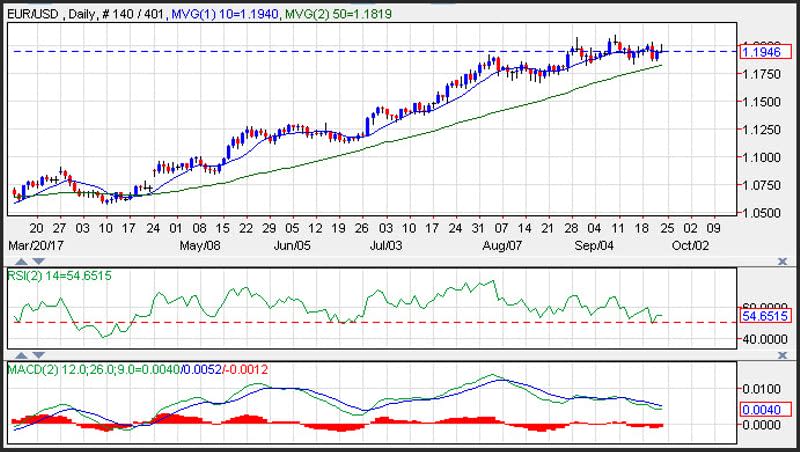EUR/USD Daily Technical Analysis for September 25, 2017
EUR/USD faded from session highs as U.S. yield remain robust. The ECB’s Draghi said that the EU is “not there” yet on inflation and “that is why monetary policy remains extraordinarily accommodative”. Divergent Fed and ECB policy paths should keep the euro pressured for the foreseeable future. Stronger than expected PMI data in Europe initially buoy the currency pair.
The EUR/USD currency pair settled near the 10-day moving average after testing higher levels during the European trading session. Support is seen near the 50-day moving average at 1.1819. Resistance is seen near the September highs at 1.2092. Momentum is neutral as the MACD (moving average convergence divergence) prints in the red with a flat trajectory which reflects consolidation.

ECB Draghi says “not there” yet on inflation
Draghi stressed once again that the central bank’s goal is to “ensure price stability and price stability is defined as an inflation rate which is close to 2%”, adding that “today that means we are not there yet” and that “that is why monetary policy remains extraordinarily accommodative”. He admitted that a prolonged period of “variable or negative interest rates is a fertile ground for the materialization of financial stability risk”, but added that “we hadn’t seen much of this”, although, there may be “local situation of valuations of assets that are overstretched”, stressing that “we have to keep an eye that these are not systemic”. No sign there that Draghi is turning overly hawkish, with the reference to still low inflation backing expectations for yet another QE extension, albeit with lower monthly purchase volumes.
EMU September PMIs surge higher for strong Q3 GDP number
Eurozone PMI readings for September came in much stronger than anticipated. The manufacturing reading jumped to 58.2 from 57.4, the services PMI came in at 55.6 and the composite jumped to 56.7 from 55.7 in the previous month. Markit said the economy showed a “burst of activity” in the last month of the quarter and data would be consistent with a quarterly growth rate of 0.7% quarter over quarter in Q3 according to Markit, the fastest growth rate since early 2015. At the same time strong orders growth, which showed the largest monthly increase since April 2011, is a good sign for growth in the last quarter of the year. The survey showed that some companies reported concerns about the strength of the EUR, but according to Markit the strong currency has so far only had a modest impact on exports.
German, French PMIs much stronger than anticipated. Both manufacturing and services readings surged higher in the top two Eurozone countries, against expectations for broadly stable confidence readings. The French composite now stands at 57.2, up from 55.2 in August, while the German composite reached 57.8, versus 55.8 in the previous month.
French Q2 GDP Was as Expected
French Q2 GDP was confirmed at 0.5% quarter over quarter as expected. Quarterly growth has held steady for three quarters now, and the annual rate was revised up to 1.8% from 1.7% reported initially. Still not a high growth rate by international standards, but clearly an improvement for France. The breakdown showed household consumption growth accelerating to 0.3% quarter over quarter from 0.1% quarter over quarter in the first quarter of the year. Investment growth fell back after surging in Q1, but at 0.9% quarter over quarter remained robust. Still, domestic demand actually contracted in the second quarter and overall growth was saved by a surprisingly strong rebound in exports, which rose 2.4% quarter over quarter, after contracting in Q1. This far outstripped the modest 0.3% quarter over quarter rise in imports.
ECB’s Hakkarainen warns NPLs remain major concern
The central bank’s Supervisory Board member said in a speech in Frankfurt that while the central bank doesn’t “want a situation where bank losses generated during macroeconomic downturn are socialised as a matter of course”, “in some cases it is understandable and even desirable to use an element of public support within the set of solutions”. Nothing really new there with regard to monetary policy, but a confirmation that despite all efforts the link between private and government debt hasn’t been severed totally yet. This is especially relevant for countries such as Italy, where debt levels and NPLs remain high.
ECB’s Constancio said that the Recent EUR rise may have limited effect
ECB Vice President Constancio said that based on recent research “the recent euro appreciation may have a more limited dampening effect on inflation than what would be implied by historical averages”, adding that “the empirical evidence confirms that different shocks exert different effects on inflation, possibly even leading to inflation responses in the opposite direction of the exchange rate movement”. Constancio also said that the fact that the coefficient of the economic slack in the Philipps curve is still significant together with “the slight steepening of the Phillips curve in the euro area, this gives some hope that the future closing of the output gap will allow us to gradually reach our inflation target”.
This article was originally posted on FX Empire

